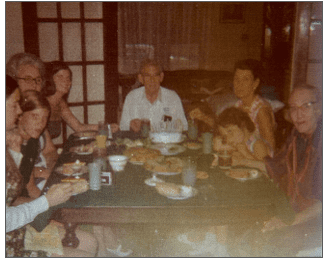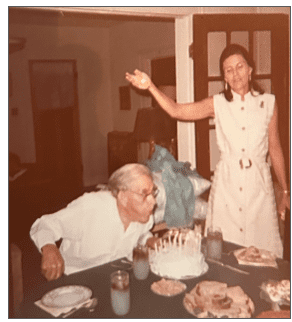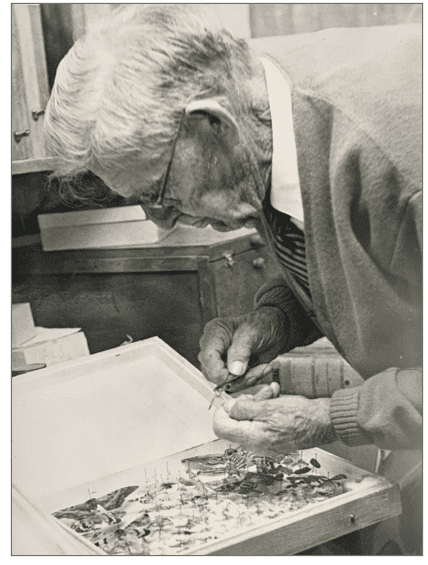
The months and years after Edith’s death were difficult for Orville. He missed his her so much.
Orville occupied his time reading, gardening, and consolidating his various scientific collections. He donated thousands of insect specimens, along with hundreds of samples of native woods and numerous scientific documents and research papers he had authored to Angelo State College.
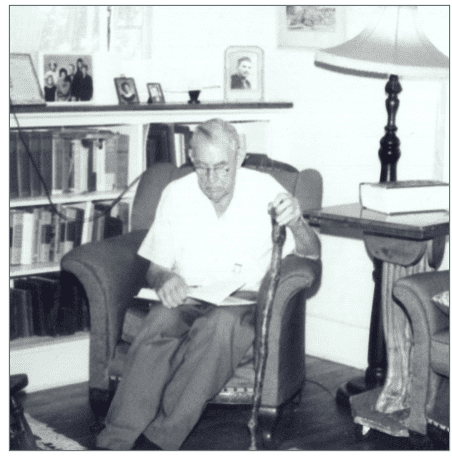
Thankfully, Orville continued his project of documenting our family history. We could not have compiled this detailed account of the Knoll/Babcock family without our grandfather’s efforts. For this we are ever so grateful!
Newspaper article which highlights the contribution of Orville’s specimen collection to Angelo State College.
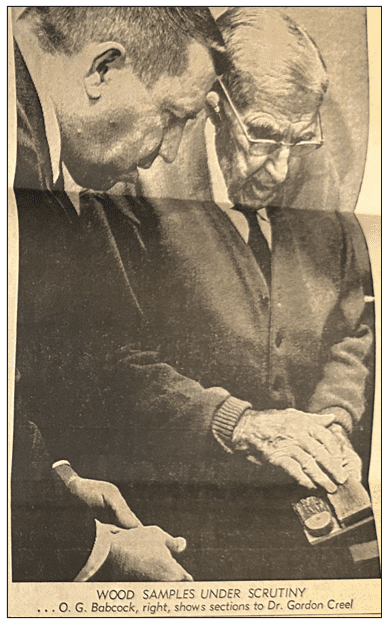
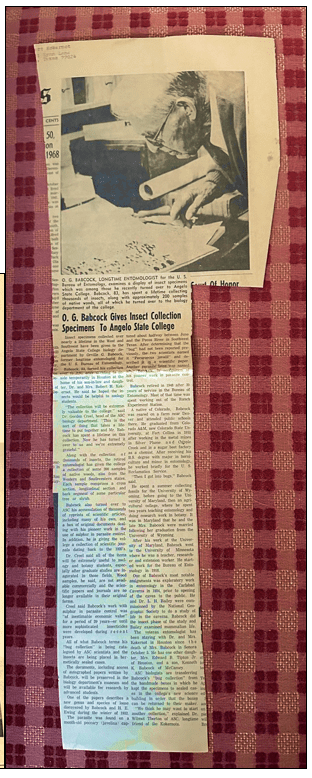
O.G. Babcock Gives Insect Collection Specimens to Angelo State College
(published early 1969)
Insect specimens collected over nearly a lifetime in the West and Southwest have been given to the Angelo State College biology department by Orville G. Babcock, former longtime entomologist for the U.S. Bureau of Entomology. Babcock, 83, turned his collection over to ASC after deciding to reside temporarily in Houston at the home of his daughter and son-in-law, Dr. and Mrs. Robert H. Kokernot. He said he hoped the insects would be helpful to zoology students.
“The collection will be extremely valuable to the college,” said Dr. Gordon Creel, head of the ASC biology department. “This is the sort of thing that takes a lifetime to put together, and Mr. Babcock has spent a lifetime on this collection. Now he has turned it over to us, and we are extremely grateful.” Along with the collection of thousands of insects, the retired entomologist has given the college a collection of some 200 samples of native woods, also from the Western and Southwestern states. Each sample comprises a cross section, longitudinal section and bark segment of some particular tree or shrub.
Babcock also turned over to ASC his accumulation of thousands of reprints of scientific articles including many of his own, and a box of his own, and a box of original documents dealing with his pioneer work in the use of sulphur in parasite control. In addition, he is giving the college a collection of scientific journals dating back to the 1920’s. Dr. Creel said all of the items will be extremely useful to zoology and botany students, especially after graduate studies are inaugurated in those fields. Wood samples, he said, are not available commercially and the scientific papers and journals are no longer available in their original forms. Creel said Babcock’s work with Sulphur in parasite control was “of inestimable economic value” for a period of 39 years – or until more sophisticated insecticides were developed during recent years.
All of what Babcock terms his “bug collection” is being catalogued by ASC scientists and the insects are being placed in hermetically sealed cases. The documents, including scores of autographed papers written by Babcock, will be preserved in the biology department’s museum and will be available for research by advanced students.
One of the papers describes a new genus and species of louse discovered by Babcock and H.E. Ewing during the winter of 1932. The parasite was found on a month-old peccary (javelina) captured about halfway between Juno and the Pecos River in Southwest Texas. After determining that the “bug” had not been reported previously, the two scientists named it “Pecaroecus javalii” and described it in a scientific paper. Another parasite later was named after Babcock in recognition of his pioneer work in parasite control.
Babcock retired in 1948 after 30 years of service in the Bureau of Entomology. Most of that time was spent working out of the Ranch Experiment Station. A native of Colorado, Babcock was reared on a farm near Denver and attended public schools there. He graduated from Colorado A&M, now Colorado State University at Fort Collins in 1910 after working in the metal mines in Silver Plume and Cripple Creek and in a sugar beet factory as a chemist. After receiving his B.S. degree with major in horticulture and minor in entomology, he worked briefly for the U.S. Reclamation Service. “Then I got into bugs,” Babcock said.
He spent a summer collecting fossils for the University of Wyoming, before going to the University of Maryland then an agricultural college, where he spent two years teaching entomology and doing research in botany. It was in Maryland that he and the late Mrs. Babcock were married following her graduation from Colorado A&M in Ft. Collins. After his work at the University of Maryland, Babcock went to the University of Minnesota where he was a teacher, researcher and extension worker. He started work for the Bureau of Entomology in 1918.
One of Babcock’s most notable assignments was exploratory work in entomology in the Carlsbad Caverns in 1924, prior to opening of the caves to the public. He and Dr. L.H. Bailey were commissioned by the National Geographic Society to do a study of life in the caverns. Babcock did the insect phase of the study and Bailey examined mammalian life.
The veteran entomologist has been staying with Dr. and Mrs. Kokernot in Houston since the death of Mrs. Babcock in Sonora October 5. He has one other daughter, Mrs. Edward B. Tipton Jr. of Houston, and a son, Kenneth K. Babcock of McCamey.
ASC biologists are transferring Babcock’s “bug collection” from the handmade boxes in which he kept the specimens to sealed cases in the college’s new science building in order that the boxes can be returned to their maker. “We think he may want to start another collection,” explained Dr. Wilmot Thorton of ASC, longtime friend of the Kokernot’s.
Orville wrote the following letter to Edith May early in 1969, just a few months after Edith’s death. One can sense the effort he is making to ease the concerns Edith May has for her dear father being alone.

Dearest Edith May:
Well, well. Everything is going along just fine. Have just had my own supper. Tomato soup. High grade hash – no suet nor fats, applesauce, sliced bread, coffee. Fills and filled up. For dinner I had a fine turkey dinner, coffee and bread. Still have 3 loaves of bread left. O yes, ate one donut.
Expected Mrs. Mimms (?) on Monday. Will tell you more later.
Have been up to San Angelo State College to show Kenneth and Faegene the specimens on exhibit. Then we had to do some talking. Of course, fooling around all day, we did not get away until about 9 p.m. Kenneth and Faegene had to visit Myrle near the college. But as we left, stopped at some high tone restaurant. All $2. I refused. I took French fry potatoes and onion and nothing else. Then had more than what I could eat. Darn these big meals. It’s all to get rich quick. Today I sent in my materials on my work with Kernal (Colonel) Goodnight’s to be mimeographed. Last Sunday I stayed at home and worked. Today I attended church. Something is wrong at church. Small attendance.
Mrs. Selman has ordered the book on vanishing peoples for the church. They have many biblical books and allied material, but the books are not being read. They are not interested in Sunday school stuff. They want something better.
Have trimmed one of the shrubs and tomorrow afternoon I shall put out some daffodils on Mother's grave. Am doing fine. Just give me time.
Love from Daddy

Orville celebrated his 87th birthday on July 21, 1972, with Edith May, Gertrude, Jan, Diana, Hilde, Donna, Marie Watkins and Ruth Shurley.
